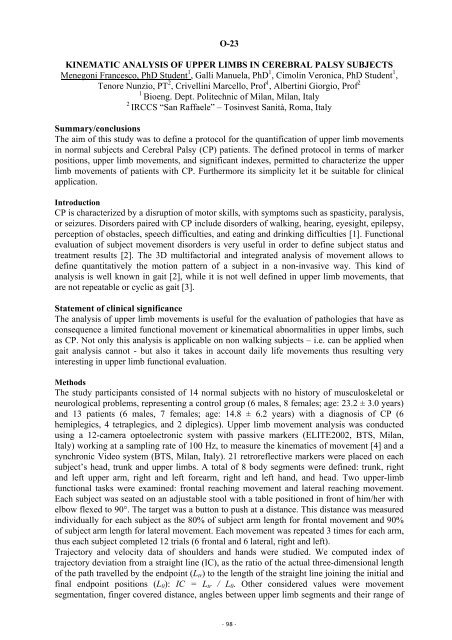1st Joint ESMAC-GCMAS Meeting - Análise de Marcha
1st Joint ESMAC-GCMAS Meeting - Análise de Marcha
1st Joint ESMAC-GCMAS Meeting - Análise de Marcha
Create successful ePaper yourself
Turn your PDF publications into a flip-book with our unique Google optimized e-Paper software.
O-23<br />
KINEMATIC ANALYSIS OF UPPER LIMBS IN CEREBRAL PALSY SUBJECTS<br />
Menegoni Francesco, PhD Stu<strong>de</strong>nt 1 , Galli Manuela, PhD 1 , Cimolin Veronica, PhD Stu<strong>de</strong>nt 1 ,<br />
Tenore Nunzio, PT 2 , Crivellini Marcello, Prof 1 , Albertini Giorgio, Prof 2<br />
1 Bioeng. Dept. Politechnic of Milan, Milan, Italy<br />
2 IRCCS “San Raffaele” – Tosinvest Sanità, Roma, Italy<br />
Summary/conclusions<br />
The aim of this study was to <strong>de</strong>fine a protocol for the quantification of upper limb movements<br />
in normal subjects and Cerebral Palsy (CP) patients. The <strong>de</strong>fined protocol in terms of marker<br />
positions, upper limb movements, and significant in<strong>de</strong>xes, permitted to characterize the upper<br />
limb movements of patients with CP. Furthermore its simplicity let it be suitable for clinical<br />
application.<br />
Introduction<br />
CP is characterized by a disruption of motor skills, with symptoms such as spasticity, paralysis,<br />
or seizures. Disor<strong>de</strong>rs paired with CP inclu<strong>de</strong> disor<strong>de</strong>rs of walking, hearing, eyesight, epilepsy,<br />
perception of obstacles, speech difficulties, and eating and drinking difficulties [1]. Functional<br />
evaluation of subject movement disor<strong>de</strong>rs is very useful in or<strong>de</strong>r to <strong>de</strong>fine subject status and<br />
treatment results [2]. The 3D multifactorial and integrated analysis of movement allows to<br />
<strong>de</strong>fine quantitatively the motion pattern of a subject in a non-invasive way. This kind of<br />
analysis is well known in gait [2], while it is not well <strong>de</strong>fined in upper limb movements, that<br />
are not repeatable or cyclic as gait [3].<br />
Statement of clinical significance<br />
The analysis of upper limb movements is useful for the evaluation of pathologies that have as<br />
consequence a limited functional movement or kinematical abnormalities in upper limbs, such<br />
as CP. Not only this analysis is applicable on non walking subjects – i.e. can be applied when<br />
gait analysis cannot - but also it takes in account daily life movements thus resulting very<br />
interesting in upper limb functional evaluation.<br />
Methods<br />
The study participants consisted of 14 normal subjects with no history of musculoskeletal or<br />
neurological problems, representing a control group (6 males, 8 females; age: 23.2 ± 3.0 years)<br />
and 13 patients (6 males, 7 females; age: 14.8 ± 6.2 years) with a diagnosis of CP (6<br />
hemiplegics, 4 tetraplegics, and 2 diplegics). Upper limb movement analysis was conducted<br />
using a 12-camera optoelectronic system with passive markers (ELITE2002, BTS, Milan,<br />
Italy) working at a sampling rate of 100 Hz, to measure the kinematics of movement [4] and a<br />
synchronic Vi<strong>de</strong>o system (BTS, Milan, Italy). 21 retroreflective markers were placed on each<br />
subject’s head, trunk and upper limbs. A total of 8 body segments were <strong>de</strong>fined: trunk, right<br />
and left upper arm, right and left forearm, right and left hand, and head. Two upper-limb<br />
functional tasks were examined: frontal reaching movement and lateral reaching movement.<br />
Each subject was seated on an adjustable stool with a table positioned in front of him/her with<br />
elbow flexed to 90°. The target was a button to push at a distance. This distance was measured<br />
individually for each subject as the 80% of subject arm length for frontal movement and 90%<br />
of subject arm length for lateral movement. Each movement was repeated 3 times for each arm,<br />
thus each subject completed 12 trials (6 frontal and 6 lateral, right and left).<br />
Trajectory and velocity data of shoul<strong>de</strong>rs and hands were studied. We computed in<strong>de</strong>x of<br />
trajectory <strong>de</strong>viation from a straight line (IC), as the ratio of the actual three-dimensional length<br />
of the path travelled by the endpoint (Ltr) to the length of the straight line joining the initial and<br />
final endpoint positions (L0): IC = Ltr / L0. Other consi<strong>de</strong>red values were movement<br />
segmentation, finger covered distance, angles between upper limb segments and their range of<br />
- 98 -
















